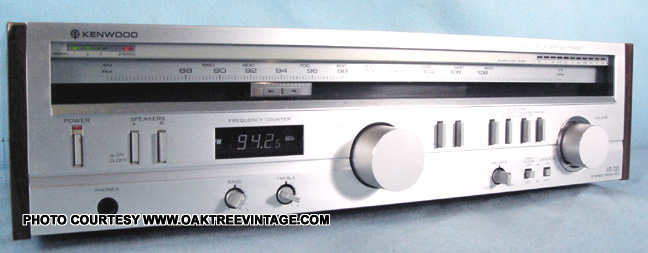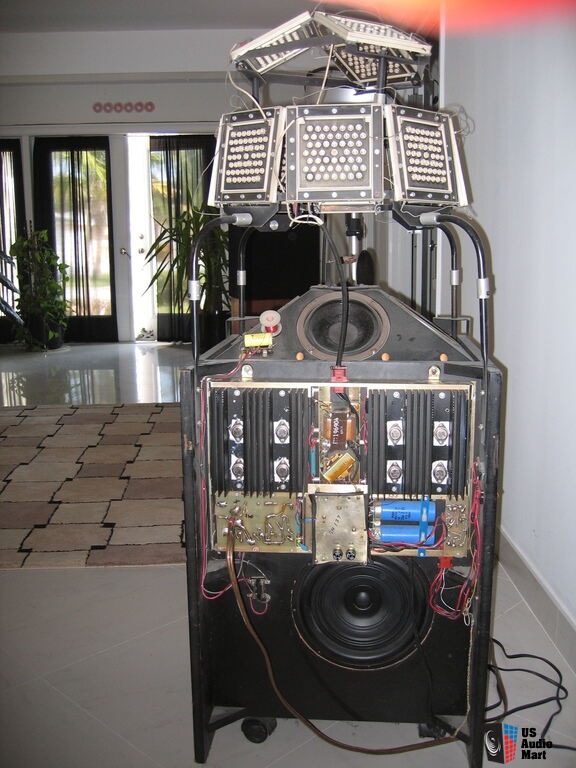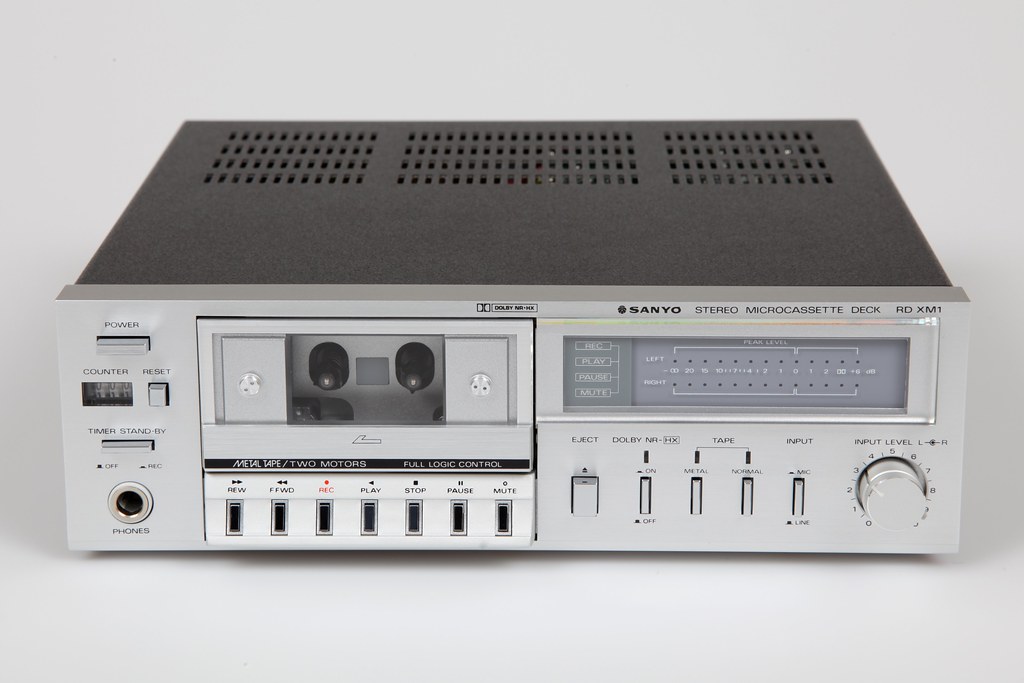You are using an out of date browser. It may not display this or other websites correctly.
You should upgrade or use an alternative browser.
You should upgrade or use an alternative browser.
Hi-fi with uncommon features or tricks?
- Thread starter birchoak
- Start date
With a good antenna the Realiatic auto lock works very well. The TM-1000 tuner I use in the garage has it and stays locked and doesn't drift. However with a very weak station or one that has bounced around will still lock, but will be off a bit when it does. But for those few stations turning off the feature lets you tune it in manually.Kinda hard to see on this borrowed pic of a Kenwood, but there are three LEDs in the tuning "pointer".
The center one tells you it is tuned by turning from red to green . The outer ones light as needed and point the way for you to hit "tuned"
If you so much as touch the tuning knob (on mine, you only have to be VERY close), the center LED turns red to show it is not locked on yet.
The Realistic model below it has an auto-tune feature that locks to the correct frequency after you bring the tuning marker to the closest position (no visual, it just does the job).


Not sure that was from the factory. Early models had none. The XG-8MKIII added a piezo above 10k.And it has a ribbon tweeter...very interesting.
It was an incredible speaker that forever had a lasting effect on me. About that time, I joined JWC on a trip south of Atlanta to meet a gentlemen who had the Mark Levinson HQD system. Hartley 18" sub, stacked Quad 57s with Decca ribbons on top. It was impressive, but I still preferred the Daytons for their disappearing act and dynamics.Thanks for introducing this to me.

JoeESP9
ESL's & tubes since 83
That's why a variable loudness control as on many Yamaha products is the best implementation of a loudness control. Once you have made all the sources the same level you use the volume control to set the highest level you use. You then use the variable loudness control to lower the volume and it applies the correct amount of compensation. Doing it this way takes into account speaker sensitivity and listening distance.I don't think so - 'cause for that purpose the pre-amp/integrated amp/receiver would have to know speaker sensitivity and listening distance.
Greetings from Munich!
Manfred / lini
AFAIK McIntosh is the only manufacturer that offers input level adjustment and a variable loudness control.
Dayton Wright panels were full range - albeit with somewhat limited extension in the top octave.Actually, I believe that's the outlet aperture for the electrostatic tweeter panels within the plastic box.
There actually is a distinction between "full range electrostats" (D-W, Acoustat, Sound Lab) and "electrostats that operate full range" having separate frequency specific panels (Quad 57, KLH 9, King Sound, Martin-Logan CLZ). As an absolute coherency freak, I prefer the former type. One pebble in the pond.
damacman
Resident Psycho
Some of those ML setups had Hartley 24" pairs ...Not sure that was from the factory. Early models had none. The XG-8MKIII added a piezo above 10k.
It was an incredible speaker that forever had a lasting effect on me. About that time, I joined JWC on a trip south of Atlanta to meet a gentlemen who had the Mark Levinson HQD system. Hartley 18" sub, stacked Quad 57s with Decca ribbons on top. It was impressive, but I still preferred the Daytons for their disappearing act and dynamics.
View attachment 1226292
That was the HQD! My first pic didn't show them very well. Here's another where you can see the ML-2 amps, LNC-2 crossover and the "H" part of the system behind the Quads. Since the xover was at 100 hz, you really needed a pair. The Decca ribbons were in the space between the QuadsSome of those ML setups had Hartley 24" pairs ...

Last edited:
That would have been useful about twenty years ago when I recorded a phone message using the Twilight Zone music and intro. Play music on the left and record that with voiceover on the right.How about a micro cassette player and a regular cassette player in a boombox?
You're traveling to another dimension. A dimension not only of sight and sound but of mind. There's a sign post ahead. You're about to enter the Message Zone.
Fair enough.Dayton Wright panels were full range - albeit with somewhat limited extension in the top octave.
There actually is a distinction between "full range electrostats" (D-W, Acoustat, Sound Lab) and "electrostats that operate full range" having separate frequency specific panels (Quad 57, KLH 9, King Sound, Martin-Logan CLZ). As an absolute coherency freak, I prefer the former type. One pebble in the pond.
My main experience with electrostatic speakers of any sort have been Stax 'earspeakers', and a pair of B&W DM70s which used a set of electrostatic panels on top as tweeters. Speaking of electrostatic speakers, easily the kookiest ones I've ever seen belong to a friend of mine, though I have yet to hear them in action, the mighty Cosmostatics:

(They look a bit less crazy with the covers installed, but only just.
-Adam
First of all, it's a sealed aluminum box with wooden caps and the sound doesn't "get out" - the outer mylar diaphragm that covers the entire front surface radiates the sound produced by the panels. You'll note some wrinkling towards the upper right section. It is in need of heat treatment to bring that fully taut.Wasn't sure how the sound gets out of the sealed plastic box
There is no "opening" else the SF6 would escape. It's sealed!
Indeed the Cosmostatics are a bit funky looking, but what is evident is their attempt to minimize beaming via the angled mounting. Dr. West of Sound Lab takes a somewhat similar approach with his designs. While there is but but one large diaphragm that covers the entire surface, it is attached to an angled grid structure which provides wider and controlled directivity. Each "face" is flat, but arrayed across an arc. They make 22, 45 and 90 degree models. The 22s are intended for professional use in multiple arrays like Ray Kimber demoed at RMAF for many years.
Here is a view from the rear of a U-1PX. Note also that the height of the grids increases from top to bottom to minimize inherent resonance (like the view in my avatar). With the latest grid design, they are tallest at the top and bottom and are smallest in the center which is said to improve dynamic range in the bass.

Last edited:
damacman
Resident Psycho
Yep - that's the ones. I saw a pair of the stacked panels only when visiting Madrigal for sales training in 1999 - I was the rep for Proceed in Central TX at the time.That was the HQD! My first pic didn't show them very well. Here's another where you can see the ML-2 amps, LNC-2 crossover and the "H" part of the system behind the Quads. Since the xover was at 100 hz, you really needed a pair. The Decca ribbons were in the space between the Quads
View attachment 1226499
sKiZo
Hates received: 92644 43.20°N 85.50°W
An alarm clock is a great idea in the bedroom. It doesn't miss on the time too.
Those old flipper clocks are way cool ... and also difficult to find one that still works!
damacman
Resident Psycho
some are selling for ludicrous money...Those old flipper clocks are way cool ... and also difficult to find one that still works!
DaveVoorhis
Addicted Member
When I was a kid and they were pretty new, I really, really, really wanted one but I couldn't afford one and nobody would get me one. I finally got one at a yard sale when I was a teenager. Hooray! Such joy!Those old flipper clocks are way cool ... and also difficult to find one that still works!
Turns out the thing made a soft, barely-audible *plip* every minute when each number leaf fell. It kept me awake all night waiting for the next bloody *plip*. So disappointed!
I've never really gotten over that.
When I was 12, I begged my dad for one for a couple of months. He finally bought the GE model I was covetting and I put it in my bookshelf headboard.When I was a kid and they were pretty new, I really, really, really wanted one but I couldn't afford one and nobody would get me one. I finally got one at a yard sale when I was a teenager. Hooray! Such joy!
Turns out the thing made a soft, barely-audible *plip* every minute when each number leaf fell. It kept me awake all night waiting for the next bloody *plip*. So disappointed!
I've never really gotten over that.
It made that blip noise, and it had a slight motor whirr. All amplified by the bookshelf headboard. I expressed my disappointment to my dad, and he expressed his disappointment in me.
Had listen to that noise for years.
Be careful what you wish for.
sKiZo
Hates received: 92644 43.20°N 85.50°W
When I was a kid and they were pretty new, I really, really, really wanted one but I couldn't afford one and nobody would get me one. I finally got one at a yard sale when I was a teenager. Hooray! Such joy!
Turns out the thing made a soft, barely-audible *plip* every minute when each number leaf fell. It kept me awake all night waiting for the next bloody *plip*. So disappointed!
I've never really gotten over that.
I expect you'd have fun here ... I'm sure the barely audible "plip" would be drowned out by the dozen assorted mechanical clocks ticking away and announcing the hour ... some every quarter hour ... and one a grandmother ... ;-}
(DSOM got nuttin' on me!)
DaveVoorhis
Addicted Member
About ten years ago, I went on a vintage clock collecting frenzy and had them ticking and bonging all over the house. That was fine; ticking and bonging is gentle and, uh, soothingly clocky.I expect you'd have fun here ... I'm sure the barely audible "plip" would be drowned out by the dozen assorted mechanical clocks ticking away and announcing the hour ... some every quarter hour ... and one a grandmother ... ;-}
(DSOM got nuttin' on me!)
But waiting for the agonisingly soft *plip* from a flip clock is maddening. It's like Chinese water torture that tells time.
Similar threads
- Replies
- 1
- Views
- 546
- Replies
- 59
- Views
- 2K
- Replies
- 136
- Views
- 4K
- Replies
- 5
- Views
- 895





